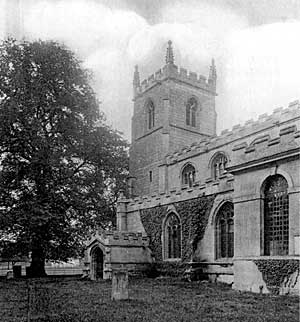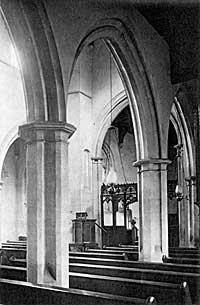The Autumn Excursion
The Excursion, which was smaller than usual, numbered twenty-five. On the arrival of the Midland train from Nottingham the part left Newark for Kelham, passing over Kelham Bridge, adjoining which is the meadow where (it is alleged) King Charles surrendered to the Scottish army.
Kelham
By THE REV. A. M. V. BAYLAY.
 Kelham church—St. Wilfrid.
Kelham church—St. Wilfrid.No part of this church is of any great antiquity, but it nevertheless possesses a peculiar degree of interest from an architectural point of view. All that we know of the state of things here before the end of the 15th century is that there was a church without side-aisles, but possessing a west tower, which still remains. Two dates may, I think, be discerned in the work of this tower, but even the lower portion is not older than the closing years of the 14th century. The gap in the string-course on the east face of the tower enables us to form an idea of the height and pitch of the roof of the older church.
At the end of the 15th century, or early in the 16th, the whole church, with the exception of the tower, was taken down and rebuilt, with side-aisles and porches. There was at that time, in the county of Nottingham, a certain man endowed with remarkable architectural genius. I say a man, because the work I am alluding to bears such strong impress of individuality, that I am unable to regard it as being the joint production of a gang of masons. This man, whose name is, to the best of my belief, quite unknown, seems to have been favoured by the Cromwells, who at that time resided at Lambley, and some of his work may be seen in the church of that place. After the Cromwells had built Tattershall Castle, they proceeded to found there a college of secular canons, for whose accommodation they completely removed the then existing Parish Church, and rebuilt it on a grand scale. They began with the west tower, which was very probably erected before the removal of the old church; and after the building of the tower, which is of an entirely different character, they entrusted the re-building of all the rest of the church to our unknown architect. Those who have seen Tattershall Church know what the work is like, and how marked is its individuality.
Here, at Kelham, we have, on a smaller scale, precisely the same work, even down to the least detail. I am unable to decide whether we have here the application of the Tattershall work to a smaller example, or whether, on the contrary, Tattershall represents the expansion of work already done at Kelham. The work of this architect shews, especially as regards pillars and capitals, distinct signs of renaissance influence. But the most marked feature is the entire absence of cusps throughout his work. In this also, I am disposed to see the influence of the renaissance, though it must not be forgotten that cuspless window-tracery had already made its appearance in this county, as may be seen at Egmanton, North Muskham, and many other churches. Our architect was not in love with the depressed four-centred Tudor arch, only employing it where it was manifestly more convenient, as in the case of doorways, and for the east window, in order to gain width without the necessity for greater height. His sense of proportion was admirable. A more perfectly proportioned small church than this it would not be possible to find, and the larger work at Tattershall deserves equal commendation. The roofs throughout the church are excellent, and the whole effect of the interior most dignified.
 Kelham church—Interior.
Kelham church—Interior.The beautiful rood-screen has unfortunately lost its loft, but the stair leading to it remains. Behind the rood there was a panelling to set it off, the height of which is indicated by the stopping of the hood-mould over the chancel arch. Above this panelling was formerly a mural painting, representing, I am told, “the Resurrection”:— probably the general resurrection of the dead, and the last judgment. The stairs, as at Tattershall, are carried up so as to give access to the leads on the nave and north aisle. A small doorway now walled up, which was reached from the rood loft, served the same purpose on the south.
At the end of the north aisle was the Lady Chapel, and in the glass may still be seen some portion of the favourite devotion—“Jesu, mercy: Lady, help.” Another chapel at the end of the south aisle, where the organ now stands, has a squint, by means of which the chief worshipper in the chapel could from his seat see the Elevation of the Host at the Parish Mass in the Chancel. I am told that, behind the organ, there is an image-bracket bearing the nail-head ornament. If so, it must have been preserved from the older church. On the south of the chancel is the mausoleum of the Suttons, erected in the 18th century. The present Gothic arch leading into it replaced, in 1874, the previous classical one. The screen is a parclose, brought from another part of the church. I am indebted to Mr. Fellows for the following note on the monument contained in the Sutton mausoleum :—“ This somewhat ponderous marble tomb is that of Robert, second Lord Lexington, and Margaret his wife, daughter and heir of Sir Giles Hungerford, of Colston, or Coulsdon, in Wiltshire. The first Lord was created by Charles I. in 1646, with the title of Baron Lexington of Averham,—Lexington being the name of the family from which the Suttons acquired, by a marriage in 1251, the large property of Averham. The arms of Lexington are argent, a cross fiory azure.
This second Lord Lexington occupied an illustrious position in the councils of the nation: the long laudatory inscription on his tomb may be summarized by saying that his talents were recognized by William III., who consulted him on all important affairs of state. He went as envoy to the courts of Hanover, Vienna, and Zell. Queen Anne also appreciated his abilities, and in 1711 sent him as ambassador to Spain, where he skilfully conducted some most delicate negotiations with King Philip, which resulted in a treaty of peace being arranged between England and Spain. But in Madrid he suffered the terrible misfortune of losing his only son and heir, William George Sutton, to whom William III. and the Duke of Zell had stood godfathers. The body, having been embalmed, was smuggled home in a bale of cloth, and buried at Kelham.1
His only surviving daughter, Bridget, married John, third Duke of Rutland; and through her the estates of Averham and Kelham passed in succession to her sons, Lord Robert and Lord George Manners, who took the name of Sutton in addition to that of Manners. The properties remain with the family of Manners-Sutton to the present time.
The second Lord Lexington died in 1723.
Outside the chancel, on the north, is the beautiful modern tomb of John Thomas, second Lord Manners, who died 1864.
On the north of the chancel was a sacristy, of which only a fragment of wall remains. There is a niche in the parapet over the east window, occupied by a statue of S. Wilfrid, the patron saint of the church, placed there when the church was restored in 1874, from the designs of Mr. Hodgson Fowler. Happy, it is said, is the country which has no history: happy indeed is the church-restoration which demands no comment.2
Some interesting fragments of the original glazing remain in the side-aisle windows: on one of these can be read the words—ROSSE . DE . FLURUS, surrounding a rose-bush. In the north aisle the original door remains;3 there is also an ancient pillar-alms box. The lower part of the pulpit is also ancient. A tablet near the tower arch records the tragic fate of a young parishioner of mine, Henry Widdowson: who, missing his footing on the gunwale of a barge which was landing coal by Kelham bridge in 1874, when there was a strong head of flood-water running, was swept away, and his body never found.
The font is, I believe, like nearly all in this neighbourhood, of Charles II. date. The registers date only from 1670.
There are three bells. The treble bears the inscription— + GOD—SAVE—THE—CHURCH, with the mark of Henry Oldfield, h+O. The tenor is also, I take it, an Oldfield bell, and bears the date 1634, and the well-known distich,—“All men that hear my mournful sound, Repent before you lie in ground.” But the second bell is much older. On the side are the initials h.p., and between them an escutcheon, on which is what I suppose is the founder’s mark. The inscription running round the crown of the bell is hard to get at, and I am sorry to say I was unable to read nearly all of it. I made out the words—Christe placeat Tibi. This bell may very well be as old as the tower in which it hangs.
A short drive brought the party to Averham.
(1) This son had been born in Vienna, 1697. He died in 1713, and was
buried temporarily at Rolleston, the mausoleum at Kelham, I suppose,
not being yet completed.
(2) Even here, the alteration of the levels of the chancel flooring
is to be regretted.
(3) Mr. Harry Gill calls my attention to the fact that this door has
been pierced with holes, three feet three inches from the floor, as if
for the defence of the church by kneeling musketeers during the civil
wars.
